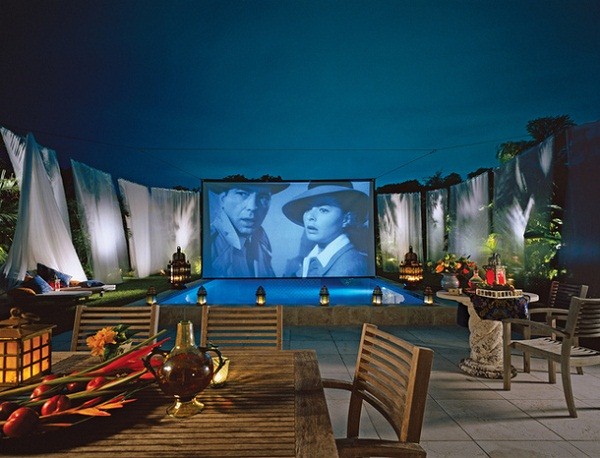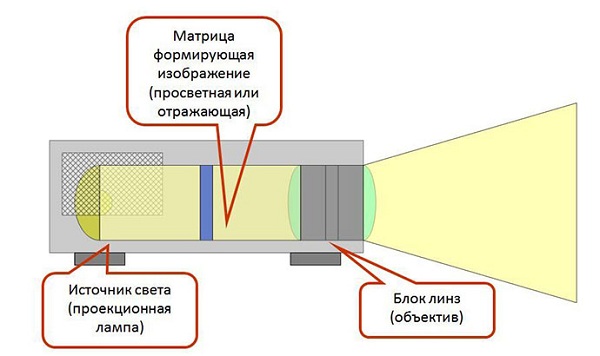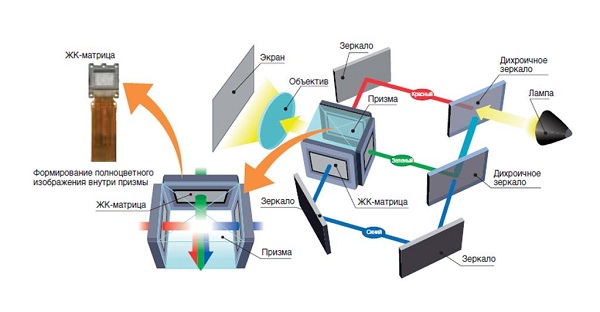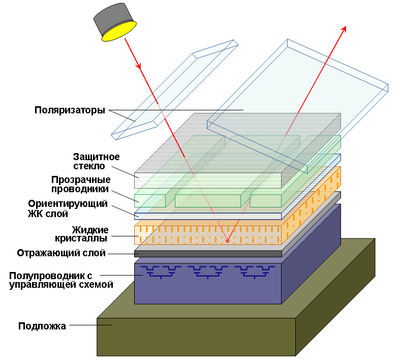Features of the choice between a projector and a TV
The most convenient way to view new film distribution or just like the moments of the video collection on the big screen. However, for this you can use two sources - a projector or TV. Which of them is more suitable for this occupation, and it is necessary to find out further.
Content
Advantages and disadvantages of the projector device
Immediately you can select the bonuses that gives the use of a home projector.
- The projector wins in front of any TV. size of reproduced image. At the same time, the picture remains fully detailed (even with all the special effects). If the room is well darkened, then this view will completely imitate the presence of a home theater, although this is a subjective opinion.

- Technically, the projector is really capable of displaying a picture that will be in the range from 1.5 to 3 times more than a large-dialed TV can do. But the advantages stand out not only in this - the image coming from the projector turns out to be much better for the eyesthan from the TV. The load on the vision is reduced due to reflected light (and not direct, as is the case with a TV device).
- Finally, a significant bonus to home is compact dimensions of the device itself. After viewing the projector can be easily removed in the closet or dresser.
But there are several shortcomings that do not make it possible to declare an absolute victory in the battle a projector vs TV. A potential user would be well aware of them.
- Sunlight can ruin the whole idyll - light transmission will significantly deteriorate. This suggests the need for black curtains on the windows (which may not fit into the concept of the interior).
- If a low-resolution video is being broadcast, this will “reveal” all the flaws in the image.
- It is better to use a special projection screen, and this implies great complexity in installation and financial costs.

Technology used in projectors
To solve for yourself the difficult question of priorities, you need to have information about the technology used in the device. Most often it is presented in such options:
- DLP;
- LCD;
- LCoS.
In the first case, special micromirror chipsWith the help of which is the formation of images. This technology is best for a uniform color tone and high image quality. Here there is a drawback - the effect of "rainbow", which is shown in the picture, especially in bright places. DLP-type requires periodic replacement of lamps (their service life should not exceed 3000 hours).

LCD technology represent the use of LCD matrices using a lens system. At the same time, excellent image quality is almost the same as in the previous version.

LCoS represents the synthesis of these technologies, which affected the price of the device. Thanks to the improvement, there are practically no flaws, but there is no particular demand for such equipment.

Pros and cons of TV panels
Any modern LCD or plasma model will show excellent performance in terms of brightness and contrast of the image.TV panels are sold in a large assortment - you can always choose the appropriate functionality for yourself. Among the obvious advantages are the following:
- ease of watching TV;
- high image quality;
- improved color rendering capabilities;
- the ability to view even in a well-lit room;
- ease of installation;
- great opportunities - from going online to viewing 3D content.
A large number of peripheral devices can be connected to the TV (it all depends on the number of interfaces provided for it).
Plays a TV device only with an image, more precisely, its size. Any projector device will be cheaper in cost than a TV, while providing an elegant field for viewing. Another drawback is the unrealistically high cost of TVs, the screen size of which will exceed 70 inches. Some models of TV-devices have limited viewing angles. And psychologists altogether declare that the presence of a large black rectangle in the interior of the apartment will act annoyingly.
What is better to choose
In a dispute as to which is better - a projector or a TV, it is necessary to evaluate energy efficiency indicator. Here the situation is ambiguous: the projector will consume more than the LCD TV receiver, but much less than the plasma counterpart.

It is worth asking this question: what can degrade the quality of the initially high-quality picture in both cases? It turns out that there are such factors - for example, in the projector it is the canvas itself, on which a beam of light falls. Being dense, it will provide a brighter image, but at the same time reduce the viewing angles. At the TV incidents with a bad picture can occur due to a bad television signal.
So which is the best option? It all depends on the intended purpose of use. If users like to watch high-quality movies or their recordings on media such as Blu-ray, definitely it is advisable to use a projector instead of a TV. However, regular viewing of TV broadcasts and broadcasts, as well as medium-quality video formats, should be viewed on a TV with a large screen diagonal.

/rating_on.png)
/rating_off.png)











